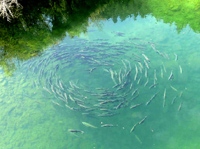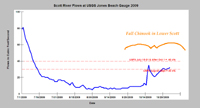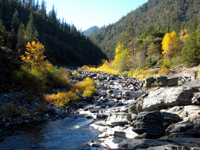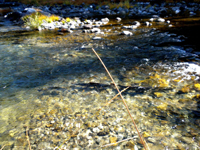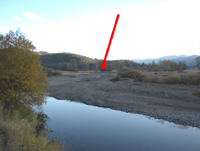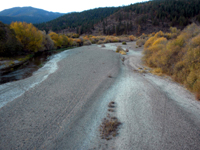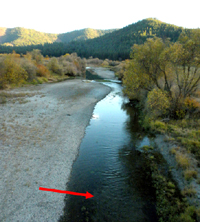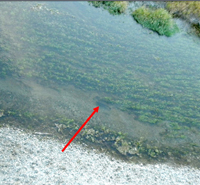Scott River Flow Crisis and Fall Chinook Salmon Run Update
Thousands of fall Chinook salmon were stranded in early fall 2009 in the lower Scott and Shasta Rivers because flows were reduced to unprecedented low levels. The following is a recap of problems for Scott River fall Chinook salmon through early November, including reports on the early portion of the run that entered the river in September.
The California Department of Fish and Game (CDFG) noted that fall Chinook trying to enter the river were not able to migrate upstream as of September 28 (memo) and were congregating in the two lowest pools above the Klamath River.
CDFG found two dead adult Chinook salmon that had succumbed to disease likely brought on by warm water conditions related to low flow and crowding because of the inability to disburse upstream. The photo above from CDFG (2009) shows adult male (below) and female Chinook mortalities and the inset is of the lower gill area showing the fish disease Columnaris. The lesions are caused by a second disease called Ich.
The Scott River adjudication calls for flows of 40 cubic feet per second (cfs) after October 1 to provide for cold water fisheries on U.S. Forest Service (USFS) lands in the lower Scott River, but excessive use of groundwater and continuing surface water diversion have kept flows below that level and prevented fall Chinook from migrating upstream.
Although October rains elevated Scott River flows above 30 cfs, as of November 1 fall Chinook were still concentrated in the Scott River canyon because flows in the valley reaches above were so low.
Some huge fall Chinook salmon are among this years run because there has been no ocean fishing for several years, but there eggs may be buried in sand in the lower Scott River during high winter flows. Passage to tributaries like the South Fork would insure higher survival.
Shackleford Creek channel was dry on the evening of November 1, 2009. Good spawning habitat that exists below the wilderness headwaters is inaccessible because the reach is dry.This also contributes to low mainstem flows in the Scott River.
In the photo of the Scott River above Shackleford Creek, the white areas show the footprint of higher flows (35 cfs) during mid-October rains. Adjudicated levels (>40 cfs) would provide even more habitat.
Fall Chinook redd (at arrow) in lower Scott Valley indicates use of sub-optimal sites where egg survival will be low because flows prevent upstream migration.
The chronic low flow conditions in the lower Scott River during late summer and fall have allowed rooted aquatic plants to become established in the channel which can partially block access. Arrow indicates migrating fall Chinook.
The problem described above for fall Chinook salmon in 2009 has occurred in almost all recent years! (See QVIR ITP comments). Salmon fishing has been shut down yet the sacrifices of fishermen may go for naught if survival of Scott River fall Chinook eggs and juveniles is low because of the continuing agriculturally induced flow crisis. How is it that a few farmers and ranchers, who are not extraordinarily rich, can get away with defying their adjudication agreement and ignoring Fish and Game and California Water Codes that provide for fisheries and recreational beneficial use protection? It is because the agencies with enforcement responsibilities are not hearing from you enough.
Caitlin Bean, Staff Environmental Scientist
California Department of Fish and Game
Northern Region
601 Locust Street
Redding, CA 96001
Office: 530-225-2273
Fax: 530-225-2381
Vicki Whitney, Chief
SWRCB Division of Water Rights
P.O. Box 2000
1001 I Street, 14th Floor
Sacramento, CA 95812-2000
(916) 341-5426
